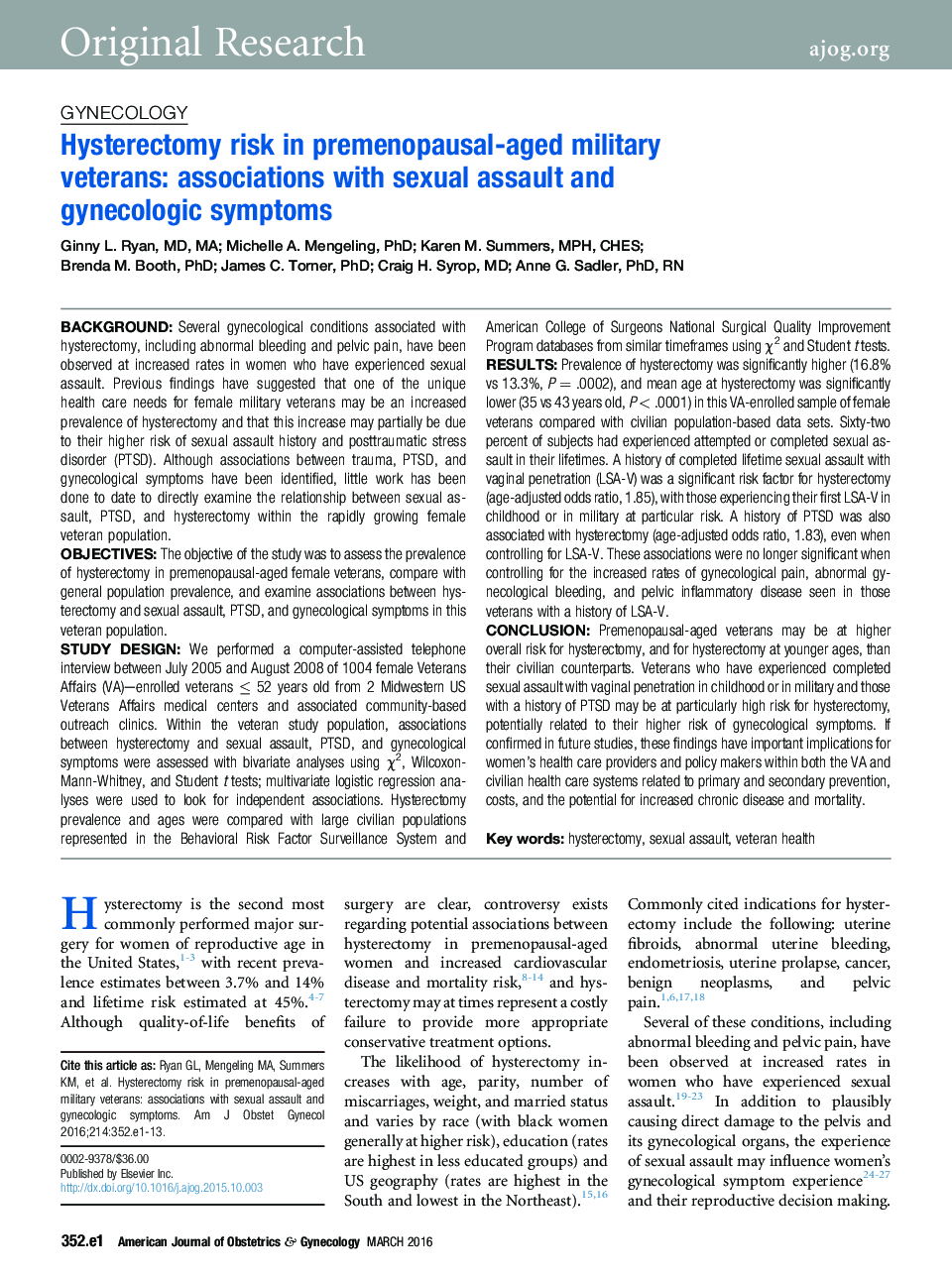| کد مقاله | کد نشریه | سال انتشار | مقاله انگلیسی | نسخه تمام متن |
|---|---|---|---|---|
| 6144653 | 1594894 | 2016 | 13 صفحه PDF | دانلود رایگان |
BackgroundSeveral gynecological conditions associated with hysterectomy, including abnormal bleeding and pelvic pain, have been observed at increased rates in women who have experienced sexual assault. Previous findings have suggested that one of the unique health care needs for female military veterans may be an increased prevalence of hysterectomy and that this increase may partially be due to their higher risk of sexual assault history and posttraumatic stress disorder (PTSD). Although associations between trauma, PTSD, and gynecological symptoms have been identified, little work has been done to date to directly examine the relationship between sexual assault, PTSD, and hysterectomy within the rapidly growing female veteran population.ObjectivesThe objective of the study was to assess the prevalence of hysterectomy in premenopausal-aged female veterans, compare with general population prevalence, and examine associations between hysterectomy and sexual assault, PTSD, and gynecological symptoms in this veteran population.Study DesignWe performed a computer-assisted telephone interview between July 2005 and August 2008 of 1004 female Veterans Affairs (VA)-enrolled veterans ⤠52 years old from 2 Midwestern US Veterans Affairs medical centers and associated community-based outreach clinics. Within the veteran study population, associations between hysterectomy and sexual assault, PTSD, and gynecological symptoms were assessed with bivariate analyses using Ï2, Wilcoxon-Mann-Whitney, and Student t tests; multivariate logistic regression analyses were used to look for independent associations. Hysterectomy prevalence and ages were compared with large civilian populations represented in the Behavioral Risk Factor Surveillance System and American College of Surgeons National Surgical Quality Improvement Program databases from similar timeframes using Ï2 and Student t tests.ResultsPrevalence of hysterectomy was significantly higher (16.8% vs 13.3%, P = .0002), and mean age at hysterectomy was significantly lower (35 vs 43 years old, P < .0001) in this VA-enrolled sample of female veterans compared with civilian population-based data sets. Sixty-two percent of subjects had experienced attempted or completed sexual assault in their lifetimes. A history of completed lifetime sexual assault with vaginal penetration (LSA-V) was a significant risk factor for hysterectomy (age-adjusted odds ratio, 1.85), with those experiencing their first LSA-V in childhood or in military at particular risk. A history of PTSD was also associated with hysterectomy (age-adjusted odds ratio, 1.83), even when controlling for LSA-V. These associations were no longer significant when controlling for the increased rates of gynecological pain, abnormal gynecological bleeding, and pelvic inflammatory disease seen in those veterans with a history of LSA-V.ConclusionPremenopausal-aged veterans may be at higher overall risk for hysterectomy, and for hysterectomy at younger ages, than their civilian counterparts. Veterans who have experienced completed sexual assault with vaginal penetration in childhood or in military and those with a history of PTSD may be at particularly high risk for hysterectomy, potentially related to their higher risk of gynecological symptoms. If confirmed in future studies, these findings have important implications for women's health care providers and policy makers within both the VA and civilian health care systems related to primary and secondary prevention, costs, and the potential for increased chronic disease and mortality.
Journal: American Journal of Obstetrics and Gynecology - Volume 214, Issue 3, March 2016, Pages 352.e1-352.e13
